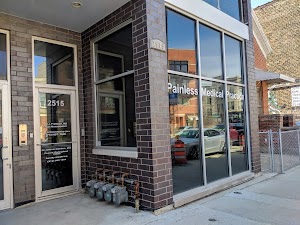Steroid Injection

What is a Steroid Injection?
A steroid injection is a treatment used to reduce inflammation and ease pain in specific areas of the body, like joints, muscles, or tendons. The injection contains corticosteroids, which are potent anti-inflammatory medications. Unlike the steroids used for bodybuilding, these steroids for pain are designed to target pain and swelling caused by conditions like arthritis, tendinitis, or joint pain.
Steroid injections are typically administered directly into the painful area, providing quick pain relief by calming down the inflammation. The effects of steroids for pain can last from a few weeks to several months, depending on the condition and the individual’s response. While it’s a quick and effective treatment, steroid injections may need to be repeated occasionally to keep the pain under control.
Types of Steroid Injections Available
Types of steroid injections include:
- Cortisone Shots. These are commonly used to reduce inflammation and pain in joints, especially for conditions like arthritis. Cortisone is fast-acting and works for several weeks.
- Hydrocortisone Injections (Corticosteroid Injection). Hydrocortisone helps treat painful joints and soft tissue issues. It’s typically used for conditions like bursitis or tendinitis.
- Triamcinolone. This steroid is commonly used for joint pain or skin conditions. It works by calming inflammation, with effects that can last several months depending on the condition and body’s response.
- Dexamethasone. With its strong anti-inflammatory properties, dexamethasone steroid injection is used for both joint and nerve-related pain.
- Methylprednisolone. This steroid is often used for joint, muscle, and nerve pain. It can be effective in reducing inflammation over a longer period, which is especially useful for chronic conditions.
Each type of treatment is chosen based on specific needs and the area being treated.


What Conditions Do Steroid Injections Treat?
Corticosteroid injections are commonly used to treat a wide variety of conditions that manifest with inflammation and pain. They’re especially helpful for people dealing with joint pain, muscle issues, or inflammatory conditions that don’t respond well to other treatments. By directly affecting the area, steroid injections reduce swelling and provide relief.
Sciatica Epidural Steroid Injection Details
An epidural corticosteroid injection is a treatment that helps ease pain from sciatica by targeting inflammation around the sciatic nerve. In a steroid injection for sciatica, a corticosteroid is injected into the epidural space near the spine, reducing pressure and swelling around the nerve roots. Many people feel relief within a few days, with effects lasting weeks to months.
What is a Knee Steroid Injection
A knee steroid injection is a treatment used to reduce pain and inflammation in the knee joint, for conditions like arthritis. In a steroid injection for knee pain, a corticosteroid is injected directly into the knee to treat inflammation, helping to ease pain. This procedure is quick, with many people feeling relief within a few days. The effects of a steroid injection in the knee can last from several weeks to a few months.
Steroid Shot for Allergies
A steroid shot for allergies can help when allergy symptoms are severe or persistent. This shot contains corticosteroids that reduce inflammation in the body, calming allergy symptoms like itching, sneezing, and nasal congestion. Unlike daily allergy meds, a steroid shot offers longer-lasting results, often working for weeks or even months. It’s a good option for those who struggle with seasonal allergies or have symptoms that don’t respond to other treatments.
Shoulder Steroid Injection Details
A corticosteroid injection for shoulder pain is a treatment that helps reduce inflammation and pain in the shoulder joint. This type of injection is commonly used for conditions like rotator cuff issues, arthritis, or bursitis. A corticosteroid is injected directly into the shoulder joint, targeting the inflamed area. Many people feel relief within a few days, with effects lasting from several weeks to a few months.
Steroid Injection in Hip and How Does it Work
A steroid injection in the hip helps reduce pain and inflammation for conditions like arthritis, bursitis, or hip joint issues. In a steroid injection for hip pain, a corticosteroid is injected directly into the hip joint or surrounding area. Steroid hip injection provides relief by calming down the inflammation, making it easier to move without pain. Most people start feeling relief within a few days, and the effects can last from several weeks to months.
Steroid Injections for Back Pain Treatment
A corticosteroid injection in the back is a treatment designed to ease pain and inflammation in the spine, treating conditions like sciatica, herniated discs, or spinal arthritis. A lumbar corticosteroid injection targets the lower back area, while a spinal corticosteroid injection can be given in other parts of the spine, depending on the pain location. These injections deliver corticosteroids directly to the irritated nerves, reducing inflammation and pain. Many people experience relief within a few days, and effects can last from weeks to months.
Steroid Injection Procedure Details
Here’s how a typical steroid injection procedure goes in general, though steps may vary depending on the condition being treated and the area of the body:
- Preparation. The area is cleaned, and sometimes a numbing agent is applied to make the process painless. Your doctor at the pain management clinic will discuss the specific area where the injection will be given.
- Positioning. You’ll be positioned to allow easy access to the treatment area, whether it’s the shoulder, knee, or spine.
- Guided Placement. For maximum accuracy, some procedures use imaging guidance, like ultrasound or X-ray, to help place the pain-relief injections needle in just the perfect spot.
- Injection. The doctor injects the steroid. The whole injection is generally quick.
- Aftercare. You’ll likely rest briefly before leaving and receive simple aftercare tips. Most people can return to normal activities soon after.


What to Expect After the Steroid Injection?
After a steroid injection, you may notice temporary relief right away due to the numbing agent, but the full effects typically take a few days to work as the steroid works to treat inflammation. Some people experience mild soreness or a “full” feeling around the injection site in the first day or two. This is normal and usually fades quickly.
As the steroid takes effect, you should start feeling a gradual reduction in pain and swelling over the following days. To help maximize the benefits, it’s generally recommended to avoid “heavy” activities for a few days after the injection. Avoid heavy lifting, intense exercise, or anything that might strain the treated area. Following these simple steps can help you get the most out of the treatment.
Benefits of Steroid Injections
- Quick Pain Relief. Steroid injections can provide fast relief for many types of pain, such as a pain-relief injections for neck pain, helping to ease neck pain within days.
- Reduces Inflammation. Whether it’s a cervical epidural steroid injection for neck and shoulder pain or a caudal pain-relief injections for lower back pain, steroids target inflammation directly, making it way easier to move and manage daily activities.
- Minimally Invasive. Compared to surgery, injections are a simple, non-surgical option that can be done in-office with minimal downtime.
- Better Quality of Life. For those with chronic conditions, pain-relief injections can reduce symptoms greatly, helping improve overall comfort.
- Personalized Treatment Options. Corticosteroid injections can treat a wide variety of areas, like intratympanic pain-relief injections for inner ear conditions, which makes this treatment highly customizable.
Potential Side Effects of Steroid Injections
- Temporary Pain or Discomfort. After a corticosteroid injection, some people feel mild pain or pressure at the injection site. This usually goes away within a day or two.
- Skin Changes. In rare cases, injections may cause a pain-relief injections scar or slight skin discoloration.
- Infection Risk. Rarely, an infection may develop at the injection site, requiring prompt medical attention.
- Temporary Increase in Blood Sugar. For people with diabetes, a temporary spike in blood sugar levels may happen, so monitoring is recommended.
- Facial Flushing. Some people may experience brief redness or flushing, especially if the injection is near the spine or neck area.
- Joint Swelling or Stiffness. Injections near joints can sometimes cause temporary swelling or stiffness.
for your pain needs
Choose Painless Medical Practice for Steroid Injections in Chicago, IL
Choose Painless Medical Practice in Chicago, IL, for your steroid injections and experience genuine care that’s also expert and fully personalized. Led by Dr. Jaroslav Tymouch, MD and Founder, our practice specializes in effective pain management created to fit each patient’s unique needs. Whether you’re dealing with joint pain, inflammation, or seeking relief with options like viscosupplementation, discography, laser therapy, regenerative medicine, Dr. Tymouch brings years of experience to help you.
At our clinic we offer a welcoming, peaceful environment and a wide variety of treatments designed to improve your life. Our team takes the time to understand your concerns and creates a plan that fits your life and health needs. Ready to experience relief with professionals who actually care? Contact Painless Medical Practice today to schedule your consultation and experience the difference!

Our Insurance Partners









FAQs About Steroid Injection
How Long Does It Take for a Steroid Injection to Work?
How Painful Is a Lumbar Epidural Steroid Injection?
A lumbar epidural pain-relief injections is generally well-tolerated, though you may feel some pressure or mild discomfort during the procedure. A local anesthetic is typically used to minimize any pain. Most patients report only minimal discomfort, and any soreness after the injection usually subsides within a day or two.
How Soon Can I Exercise After Epidural Steroid Injection?
It’s typically recommended to avoid strenuous activities and exercise for at least 24 hours after an epidural pain-relief injections. Light activities like walking are often fine, but your healthcare provider will give specific instructions based on your recovery needs and overall health.
What to Expect After Lumbar Epidural Steroid Injection?
After a lumbar epidural pain-relief injections, you may experience some initial numbness or tingling in the treated area, which usually fades within a few hours. Mild soreness at the injection site is common but should resolve quickly. Pain relief may begin within a few days, and you’ll receive instructions on activities to avoid and any signs to watch for during recovery.
How Often Can You Get a Transforaminal Epidural Steroid Injection?
Transforaminal epidural pain-relief injections are typically spaced several months apart, as needed, to avoid overuse. Most doctors recommend a maximum of three to four injections per year, depending on the patient’s response and individual circumstances. Your healthcare provider will assess the best frequency for your specific case.
What People Say About Steroid Injections
our services before


